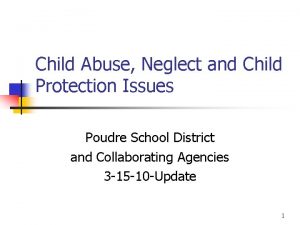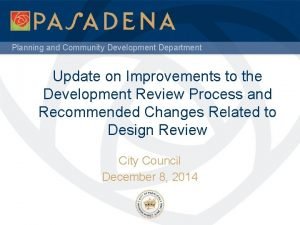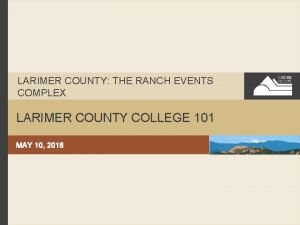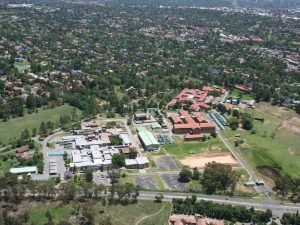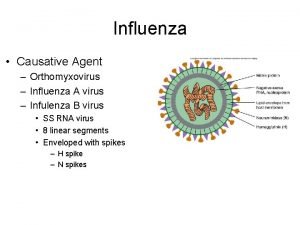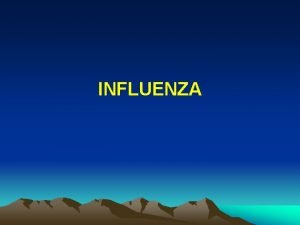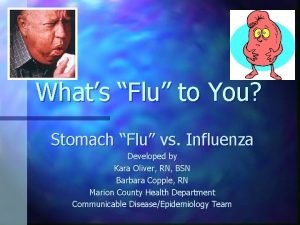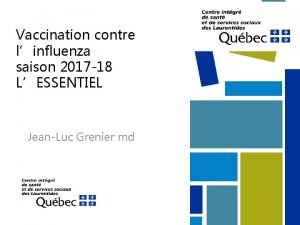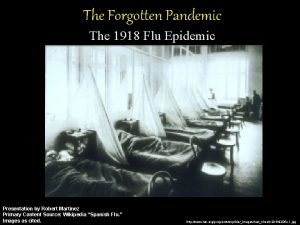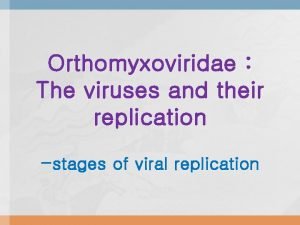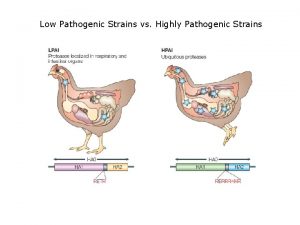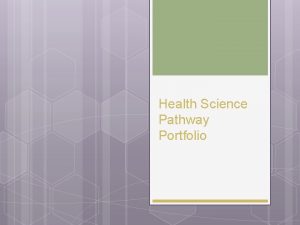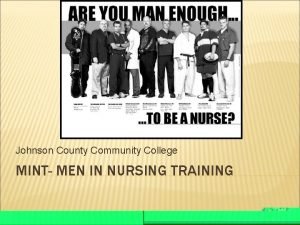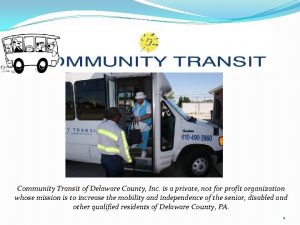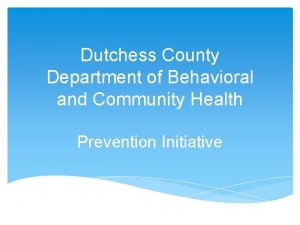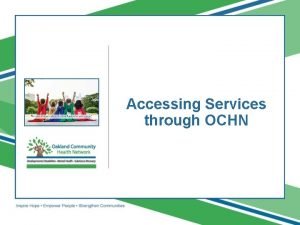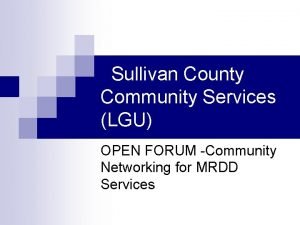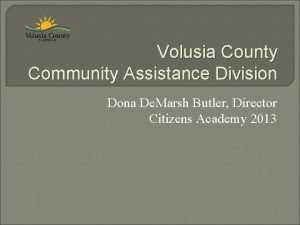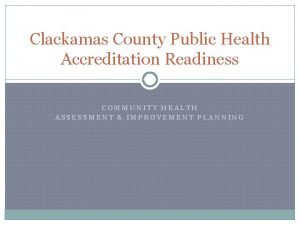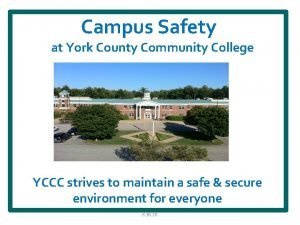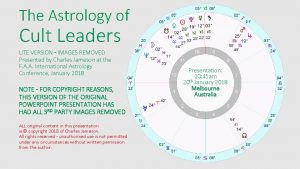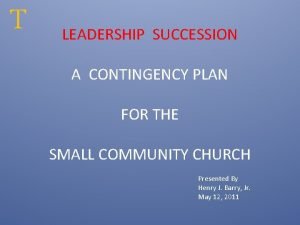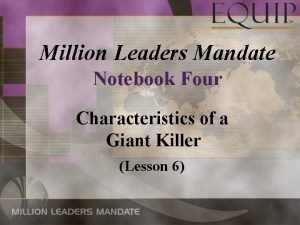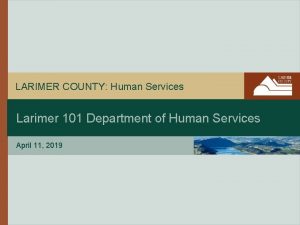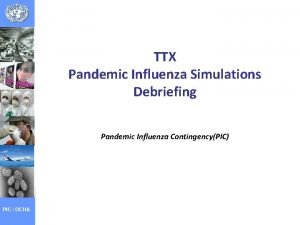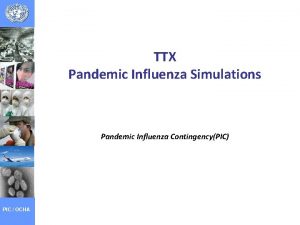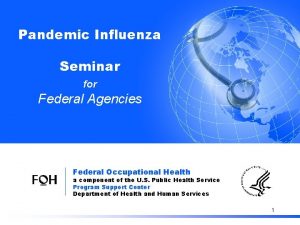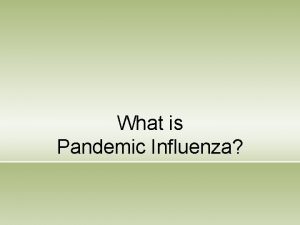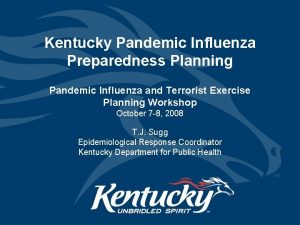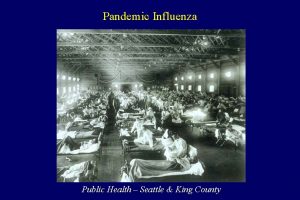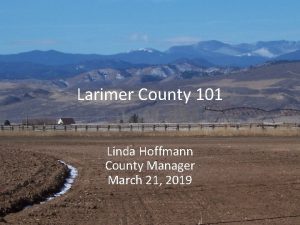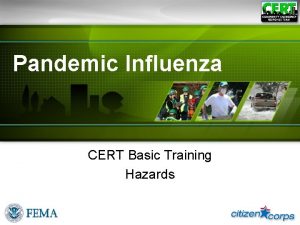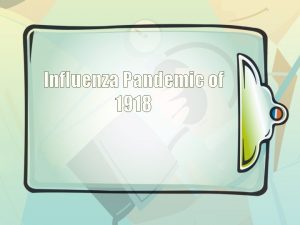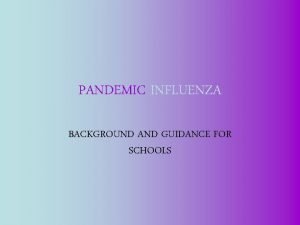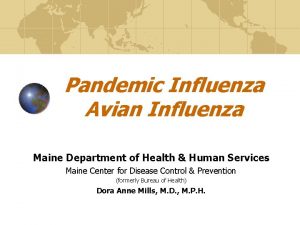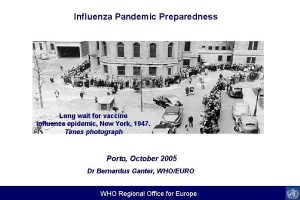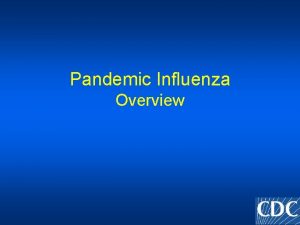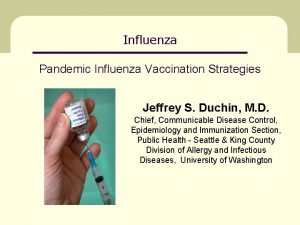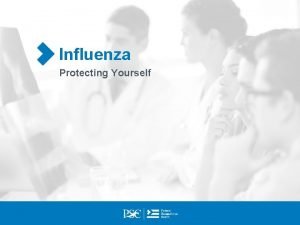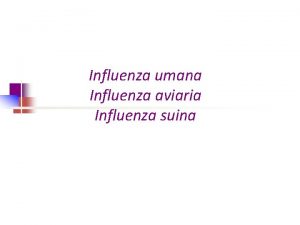Pandemic Influenza Larimer County Community Leaders Awareness Meeting

































































- Slides: 65

Pandemic Influenza Larimer County Community Leaders Awareness Meeting Dec. 6, 2005

Larimer County in 1918 n County n Fort population about 27, 000 Collins population 8, 700 n Loveland population about 5, 000

Social Environment in 1918 n Most residents involved in agriculture, directly or indirectly n World War I was the major news story n There was rationing of coal, fuel, food and other items needed for war effort n Red Cross was very active in community, supporting war effort

Outbreak begins in military training camps Deaths occurring in training camps in East were reported in local newspapers n Numerous Larimer County enlistees/ draftees were among the fatalities (4 from Camp Dix, NJ in 1 wk. ) n

Spreading to Civilians Larimer County residents were aware of growing, alarming deaths among civilians in Eastern cities n First cases in CO in Boulder; army trainees on College campus. (First cases in FC at Ag College) n

Flu shut down schools and businesses Loveland schools closed on Oct. 8 n Fort Collins closed schools on Oct. 10 n They would not reopen until Dec. 30


1918 Flu killed young adults n Highest number of deaths were in the in late teens through the mid 30’s


By the end of the outbreak n Overall, there were 67 deaths in Loveland, a town of 5, 000 in a 15 week period. n This represented an overall death rate of 1. 3% of the population.

Why are we concerned today?

“We at WHO believe that the world is now in the gravest possible danger of a pandemic" Shigeru Omi, World Health Organization , 2005

Pandemic influenza is the“the most important threat that we are facing right now. “ Julie Gerberding, CDC director, 2005

“It will be absolutely essential that local communities are well prepared, have a plan, and have sorted out who will be responsible for what. ” Michael Leavitt, U. S. HHS director

“Localities should be prepared to rely on their own resources to respond. ” U. S. draft pandemic influenza plan, 2005

Influenza n Outbreaks yearly, usually in winter months n Illness more severe for very young, elderly, or those with pre-existing health conditions n Yearly, 5 -20% of population get the flu n Annually causes >200, 000 hospitalizations in US n 36, 000 deaths yearly in US

Influenza Prevention n Yearly influenza shot n Avoid those who are ill n Wash your hands n Antivirals (in special circumstances) If you are ill--don’t come to work, cover coughs and sneezes.

Influenza Virus types – Type A: Infects humans and other animals § More severe illness § Causes regular epidemics; can cause pandemics – Type B: Infectious only to humans § Causes epidemics, but less severe illness

n Influenza A is subtyped by surface Influenza proteins – Hemagglutinin (H) § 16 different types § Helps virus enter cells – Neuraminidase (N) § 9 different types § Helps virus leave cell to infect others

Influenza n All known subtypes of Influenza A found in birds - 144 possible combinations of H’s and N’s n H 5 and H 7 cause severe outbreaks in birds n Human disease usually due to H 1, H 2, H 3 and N 1 and N 2.

Influenza The flu virus constantly changes n When it does, vaccines will be less efficient n Immune system may be unable to recognize new virus – No immunity in population for new virus —potential for pandemic

Vaccine Development Inactivated trivalent vaccine (killed vaccine) n 2 A, 1 B n Effectiveness of vaccine depends on “match” between circulating strains and those in vaccine n 2005– 2006 Influenza Season A/New Caledonia/20/99 -like A/California/7/2004 -like (H 1 N 1) (H 3 N 2) Influenza Protection B/Shanghai/361/2002 -like

Influenza—Vaccine Production n Flu vaccines first produced in 1940 s n 2 manufacturers in US for flu vaccine n 80 million doses produced by late September n 6 -9 months to produce vaccine

Influenza Pandemics n What is a Pandemic? – Outbreak in wide geographic area (global) – Effects large # of people with serious illness – Usually a new virus or one which population has not had exposure in a long time – May have rapid spread – May occur in waves

Seasonal Flu vs Pandemic Flu Seasonal n Occurs every year Occurs during winter (usually Dec-Mar) n Most recover in 1 -2 weeks without tx n Very young, very old, ill most at risk of serious illness n n n Pandemic Occurs infrequently (3 per century) Occurs any time of year Some may not recover, even with tx People of all ages may be at risk

Pandemic Influenza n Past Pandemics: – 1968 Hong Kong Flu (H 3 N 2) – 1957 Asian Flu (H 2 N 2) – 1918 Spanish Flu (H 1 N 1)

1918 -1919 influenza pandemic § Worst of past century § Estimated 20 -40% of world population ill § 40 -50 million people died worldwide § 600, 000 or more deaths in US § High mortality in young adults

Why did young people die? n Over-reaction by the immune system called “cytokine storm” n Those with the strongest immune systems affected n Older people and youngest often die of bacterial pneumonia complicating flu -treatable now with antibiotics n Even in 2005, no good treatment for “cytokine storm. ”

There are severe pandemics and mild pandemics

Infectious Disease Deaths 1900’s Deaths per 100, 000 per year 1957 1918 1968

Pandemics can last for months and come in waves


H 5 N 1 Avian Influenza n Hong Kong 1997 – 18 human cases, 6 deaths – 1. 4 million birds destroyed n Dec. 2003: Asia – Ongoing extensive outbreak in poultry – Limited human to human transmission – 125 human cases, 64 fatal n July-Aug 2005 Kazakhstan, Russia n October 2005 Turkey, Romania, Russia

H 5 N 1 Symptoms n Symptoms (human) – Fever – Shortness of breath – Cough – Pneumonia – Acute Respiratory Distress – Diarrhea, sometimes severe – Life-threatening complications

Transmission of flu virus n Incubation period of 1 -4 days for regular flu - not clear if H 5 N 1 might be longer n Can be communicable to others 24 hours before symptoms begin - and up to 5 days or more after onset (adults) or 10 or more days (children) n Usually spread through respiratory droplets or contaminated objects. May also be airborne, and perhaps thru feces.

Concern with Avian Influenza n Virus mutates rapidly n Can acquire genes from viruses infecting other species n H 5 N 1 has acquired some of genetic changes in the 1918 virus associated with human-human transmission n Causes severe disease in humans n High fatality rate


Are we more or less at risk today compared to 1918?

Why at LESS risk in 2005 n Antibiotics for bacterial pneumonia complications of influenza n Some antiviral medicines n IV fluids, ventilators n Greater ability to do surveillance, confirm diagnosis of flu

Why at LESS risk in 2005 n Rapid means of communications internet, TV, radio, email n More effective personal protective equipment n Fewer people living in each household and more rooms.

Why at MORE risk in 2005 n. A lot more international travel n 10 times more people in Larimer County, contact with far more people daily n Very little surge capacity in health care today n Greater reliance on health professionals

Why at MORE risk in 2005 n More elderly and immunecompromised people in population n Much less self-sufficient than in 1918’s (households and businesses) n Today’s society not used to rationing, sacrifice, compared to war-time 1918.

Why at MORE risk in 2005 n Far more manufactured goods and raw materials come from distant areas, especially Asia n “Just-in-time” ordering of needed supplies instead of warehousing critical items on site

Overall, are we at more or less risk? n Up to individuals, communities, states, and nations to decide as they plan for a possible pandemic

What might happen in a severe pandemic?

If it happens soon…. . n There will be little or no vaccine until 6 - 9 months after the outbreak begins n There will be very limited supplies of antiviral medicines for treatment (for 1% of populations, perhaps less). n All communities hit a about the same time n We need a plan for the short-term that assumes no effective shots or Rx

What might occur n Health system could be overwhelmed n Essential services could be at risk (fuel, power, water, food, etc. ) n “Just-in-time” supply lines could be disrupted n High mortality rates could occur n Social disruption could occur

Considerations for preparedness

Can we maintain our utilities? n Recent disasters have showed us the need for water, power, telecommunications, heat in an emergency n Could they operate with 50% of staff? n Do they stockpile materials and parts to ensure operation for 90 -120 days?

Who will provide health care? n Health workers will be disproportionately exposed and may become ill n Some will not show up due to fear n Some will not be able to leave sick family members, children out of school n Little or no surge capacity; nursing shortage; future of Medical Reserve

Will transportation/trade problems impact food supply? n Typical household has food on hand to last 3 days. n Few families have emergency reserves for a prolonged period n Low-income least able to set supplies aside for an emergency n Prices may rise quickly in emergency.

Who will help us? n Little or no state and federal assistance n Local government also limited in what it can do to assist citizens n Churches, neighbors, friends and families would need to help each other n Vulnerable groups would need extra assistance n Advance planning and stockpiling of necessities could help.

What public agencies and businesses can do as employers

Maintain Essential Services n Halt non-essential activities and redeploy staff to fill vacancies in critical services. n Cross train: Make sure all critical functions can be done by several different people.

Maintain Essential Services n Create written instructions/ procedures for critical processes that can be carried out by others n If possible, keep essential supplies/ parts stockpiled in advance to maintain services.

Increase Social Distance n Determine how to provide services with less person-to-person contact whenever possible n Increase telecommuting if possible n Use phone, web, virtual conferences to replace face-to-face meetings n Waive non-critical policies if they force in-person contact

Decrease contact exposures n Increase cleaning/sanitizing of locks/ doorknobs, faucet and toilet handles, shared keyboards, telephones, other equipment n Vacuuming/sweeping infectious particles may stir up

Decrease contact exposures n Use/provide tissues, hand sanitizers, disposable gloves if available (All could be scarce during a pandemic) n Increasing humidity may reduce virus

Provide Personal Protective Equipment n Need will vary with type business n Will be difficult to obtain in a pandemic - need to secure in advance n Masks (N 95 or better) may reduce exposure, but are difficult to wear for prolonged time or if employee has health problems.

Teach protective actions n Hand washing without recontamination n Covering cough, not using hands n Avoid putting hands to face, mouth, nose, eyes. n Staying home if any signs of illness

Prepare Communications Plan n How will key managers communicate among themselves n How will information be conveyed to customers? n How will information be conveyed to employees? n How will employees know who to call in specific situations?

Prepare for difficult HR issues n If offices are closed, will staff be paid? n If staff are needed, can they refuse to come to work? n If required to report, what protective equipment, if any, will be provided? n Can employer force someone who may be ill NOT to work? (Employees without sick leave may try to work while ill. )

Prepare for difficult HR issues n If an employee is required to work with ill people and becomes ill, is it a worker’s comp situation?

How Ready Are We? Used with permission of the Minneapolis Star-Tribune

"Every day a pandemic doesn't happen is another day we have to prepare. ” --Michael Osterholm
 Crs 19-3-304
Crs 19-3-304 Larimer county building codes
Larimer county building codes Larimer county building codes
Larimer county building codes The ranch events complex
The ranch events complex Privacy awareness and hipaa awareness training cvs
Privacy awareness and hipaa awareness training cvs Covid 19 pandemic summary
Covid 19 pandemic summary Interpandemic
Interpandemic Pandemic tabletop exercise template
Pandemic tabletop exercise template Mathalicious pandemic answer key
Mathalicious pandemic answer key Pip framework
Pip framework Spinte metallostatiche
Spinte metallostatiche Infulenza b
Infulenza b The great influenza rhetorical analysis
The great influenza rhetorical analysis Albert osterhaus
Albert osterhaus Influenza
Influenza Stomach flu vs influenza
Stomach flu vs influenza Is influenza a airborne disease
Is influenza a airborne disease Rimantidina
Rimantidina Influenza vaccine dosage chart 2019-2020
Influenza vaccine dosage chart 2019-2020 Influenza ww1
Influenza ww1 Influenza virus replication
Influenza virus replication Low pathogenic avian influenza
Low pathogenic avian influenza Explain the fccla creed
Explain the fccla creed Hosa community awareness examples
Hosa community awareness examples Today meeting or today's meeting
Today meeting or today's meeting Meeting objective
Meeting objective What is meeting and types of meeting
What is meeting and types of meeting Types of meeting
Types of meeting Hamblen county school board meeting
Hamblen county school board meeting Trinity county board of supervisors meeting
Trinity county board of supervisors meeting Joint meeting essex and union county
Joint meeting essex and union county Seminole county financial assistance
Seminole county financial assistance Klamath community corrections
Klamath community corrections Jccc nursing program
Jccc nursing program Community transit of delaware county
Community transit of delaware county Tarrant county community college northeast
Tarrant county community college northeast Dutchess county mental hygiene
Dutchess county mental hygiene Community helpers of rutherford county
Community helpers of rutherford county Oakland community health network jobs
Oakland community health network jobs Orange county community corrections
Orange county community corrections Community action thurston county
Community action thurston county Pasco county community development
Pasco county community development Lenawee county community mental health
Lenawee county community mental health Wake county human services community services center
Wake county human services community services center Sullivan county community services
Sullivan county community services Volusia county community assistance division
Volusia county community assistance division Clackamas county public health
Clackamas county public health York county community college pa
York county community college pa King county accountable community of health
King county accountable community of health Community action cycle
Community action cycle What leaders really do
What leaders really do What is house path goal theory
What is house path goal theory West java leaders reading challenge
West java leaders reading challenge Mercavia
Mercavia The intellectual and spiritual leaders.
The intellectual and spiritual leaders. Four mistakes leaders keep making
Four mistakes leaders keep making Future leaders exchange
Future leaders exchange Cult leaders zodiac signs
Cult leaders zodiac signs Succession planning for church leaders
Succession planning for church leaders School counselors as leaders
School counselors as leaders Prc-137 hf radio
Prc-137 hf radio Revolutionary leaders 1900-1939
Revolutionary leaders 1900-1939 Prayer for youth ministry leaders
Prayer for youth ministry leaders Deca prepares the next generation to be
Deca prepares the next generation to be Nctm affiliate leaders conference
Nctm affiliate leaders conference Million leaders mandate notebook one pdf
Million leaders mandate notebook one pdf
